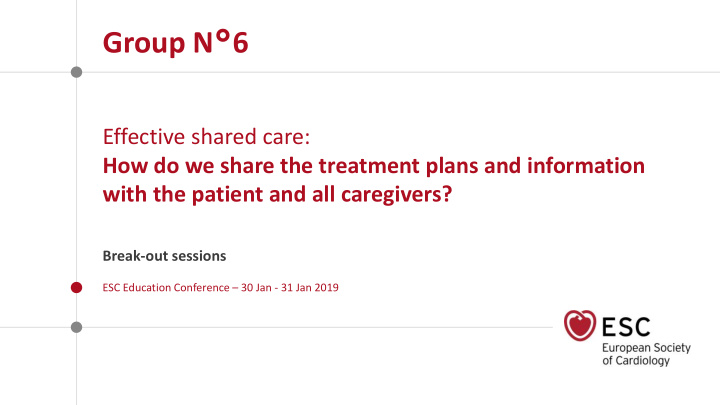



Group N ° 6 Effective shared care: How do we share the treatment plans and information with the patient and all caregivers? Break-out sessions ESC Education Conference – 30 Jan - 31 Jan 2019
Current use, challenges and limitations Group 6: How do we share the treatment plans and information with the patient and all caregivers? The question (above) exemplifies the challenges: ?rephrase as … How do we make the treatment plans together ….? 1. Challenges/limitations Culture • The patient centeredness of the organization and the community in which it is based • Clinician • Lack of physician ownership, lack of evidence of benefit, attitudes to shared care • Perceived high self-efficacy • Resources: time, people, relevant materials • Complexity of situation • Potential/perceived threat to control of situation/autonomy • Patient • Setting – critical/acute/ward/outpatient/community – and acuity of situation • Age/generation gap/health literacy • Variability in patient preference for format of information delivery • 2. Examples of practice where shared decision making is applied: situation vs strategy Example from national lead • Heart failure inter-disciplinary team • MDT/ward round/outpatient – patient/relative/caregiver presence – this situation appears to be the exception • Involvement of family/loved ones/ caregivers: end-of-life/complex/acute situations - common • MDT decision – then inform patient – then modify advice according to: • Patient preference/wishes • Financial constraints of patient/social circumstances • Managed risk/benefit perceptions of multiple medications – by clinician in context of patient • ‘informed’ (or not) consent •
Opportunities and development for the future Group 6: How do we share the treatment plans and information with the patient and all caregivers? Three basics, without which there is no hope: 1. Fundamental understanding that for success need to recognize this as time/people/materials resource requirement – otherwise irrelevant (rearranging deckchairs on the Titanic) 2. Patient-centred healthcare 3. Requirement for culture change – essential – we are not as good at this as we think we are Summary of shared decision making process 1. Determine if a shared decision making is needed? 2. When it is needed: - Evaluate and improve the shared decision team status: create a real team concept (Beatles) - Understanding the patient’s situation and communicating with compassion - Gather information regarding the patient profile and preferences and interpret these - Develop a toolbox of practical didactic solid and digital tools 3. Reassess the process and outcomes Additional considerations: Individualize and modularize approaches • Throughout the whole patient journey • Measurable benefit • Learn from other specialties • Gaming (rewards) • Using digital technology/ a variety of materials in a patient-centered way • Medical legal context of the country •
Recommend
More recommend